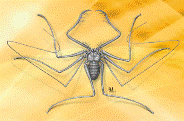Papers in the Biological Sciences

Eileen Hebets Publications
Ogre-Faced, Net-Casting Spiders Use Auditory Cues to Detect Airborne Prey (video)
Document Type
Article
Loading...
Citation
Supplementary material for Current Biology 30:24 (December 21, 2020), pp. 5033–5039; doi: 10.1016/j.cub.2020.09.048
Abstract
7-minute video presentation of research.
Prey-capture behavior among spiders varies greatly from passive entrapment in webs to running down prey items on foot. Somewhere in the middle are the ogre-faced, net-casting spiders [1] (Deinopidae: Deinopis) that actively capture prey while being suspended within a frame web [2–5]. Using a net held between their front four legs, these spiders lunge downward to ensnare prey from off the ground beneath them. This “forward strike” is sensorially mediated by a massive pair of hypersensitive, night-vision eyes [5–7]. Deinopids can also intercept flying insects with a “backward strike,” a ballistically rapid, overhead back-twist, that seems not to rely on visual cues [4, 5, 8]. Past reports have hypothesized a role of acoustic detection in backward strike behavior [4, 5, 8]. Here, we report that the net-casting spider, Deinopis spinosa, can detect auditory stimuli from at least 2 m from the sound source, at or above 60 dB SPL, and that this acoustic sensitivity is sufficient to trigger backward strike behavior. We present neurophysiological recordings in response to acoustic stimulation, both from sound-sensitive areas in the brain and isolated forelegs, which demonstrate a broad range of auditory sensitivity (100–10,000 Hz). Moreover, we conducted behavioral assays of acoustic stimulation that confirm acoustic triggering of backward net-casting by frequencies in harmony with flight tones of known prey. However, acoustic stimulation using higher frequency sounds did not elicit predatory responses in D. spinosa.We hypothesize higher frequencies are emitted by avian predators and that detecting these auditory cues may aid in antipredator behavior.


Comments
Copyright © 2020 Jay A. Stafstrom, Gil Menda, Eyal I. Nitzany, Eileen A. Hebets, and Ronald R. Hoy